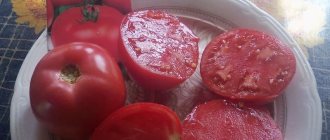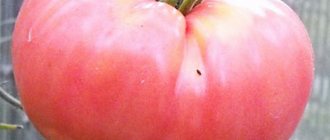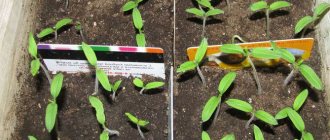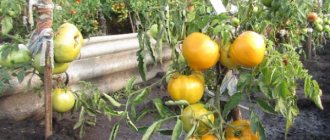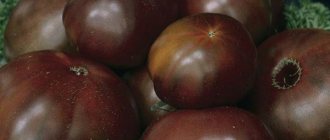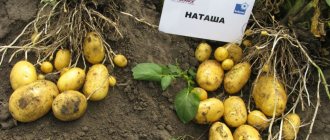Characteristics and description of the variety
The creator of the variety is considered to be the Japanese company Sakata.
The bush is determinate, low-growing, self-pollinating, up to 70 cm high. In a greenhouse it reaches 1.5 m.
Reference . Determinate type means growth is limited by its own flower raceme. The shoot of such tomatoes grows until a fruiting ovary appears at the top.
The plant is densely leafy, the leaves are medium-sized. The stem is strong and can withstand the weight of the fruit.
Early ripening hybrid - from the moment the first shoots appear until full ripening, 90-100 days pass. Recommended for cultivation in open ground and greenhouse conditions.
The culture has innate immunity against the main diseases of the nightshade family. Resistant to verticillium, cladosporiosis, fusarium wilt, and blossom end rot. Tolerates heat well for long periods of time. With sharp fluctuations in humidity, the buds do not fall off.
Productivity is high. The bush is strewn with fruits. Up to 2 kg of fruits are collected from 1 plant, provided that 4-6 seedlings are planted per 1 square meter. m.
Below is a photo of a Pink Bush tomato bush.
Plants do not require obligatory staking and pinching.
The fruits are small, symmetrical, round in shape. The color is bright pink, raspberry. The skin is smooth. There are 4-6 seed chambers. The fruits do not crack. The pulp is juicy and dense. The taste is excellent with a clear sense of sugariness.
In the photo - tomato variety Pink f1.
The species belongs to the salad category, so tomatoes are ideal for fresh consumption. They are used extremely rarely for pickles and marinades, since the taste is not preserved during heat treatment.
Tomatoes are stored for a long time and can withstand long-term transportation over any distance.
Reference . Raspberry-colored tomatoes are superior to red ones in selenium content. Selenium has a positive effect on the immune system, improves mental abilities and helps cope with depression.
Diseases and pests
The hybrid is resistant to most viral and fungal diseases of tomatoes. If you follow the rules of agricultural technology - timely watering, ventilating greenhouses, loosening the soil, the plants do not get sick and do not need additional treatments with chemicals.
They prefer to fight the main pests - slugs and ticks - with folk remedies - infusion of hot pepper, mustard, wood ash, watering with a solution of laundry soap.
Colorado potato beetles and slugs are collected by hand without using chemicals.
How to grow seedlings
Sowing begins 35-45 days before planting seedlings in open ground. The grains do not need to be processed or disinfected; the manufacturer took care of everything himself.
It is advisable to prepare the soil mixture in the fall. A little peat, humus and wood ash are added to the garden soil. All components are thoroughly mixed. To destroy pathogenic microflora, the prepared mixture is disinfected with a hot solution of dark potassium permanganate.
Reference . Wood ash is not only a source of potassium, but also a preventative against fungal diseases.
They are sown in a common wooden box, in individual peat pots or plastic cups. Before sowing, the soil is slightly moistened and compacted. The grains are carefully laid out on the soil surface at a distance of 3-4 cm from each other and sprinkled with a 1 cm layer of soil.
The crops are watered with warm water and covered with film or glass to create a greenhouse effect. Before germination, the seed does not need lighting; it only needs light moisture. The containers are left in a room where the air temperature is at least 24°C.
Shoots appear in 4-5 days. At this point, the containers are transferred to a well-lit place where the air temperature during the day is no more than 16°C, and at night – 12-13°C. This technique helps to harden young seedlings. In this mode, the seedlings are kept for 1 week, and then the temperature is raised to 21°C.
Optimal daylight hours are at least 10 hours. If there is a lack of natural light, additional lighting is provided with fluorescent lamps.
When 2 true leaves appear, pick them. During picking, the sprouts are placed in separate containers, but there is no need to place the individual containers too tightly. The seedlings will shade each other and stretch upward towards the light. This can lead to improper formation of the stem; it will become thin and long and subsequently cannot support the mass of fruit.
Water the seedlings as the top layer of soil dries with heated and settled water with the addition of a small amount of citric acid to soften.
Reference . When growing seedlings, remember that three factors are most important for it: humidity level, temperature and lighting.
A month later, the seedlings are hardened off. Start with 2-3 hours of seedlings being outdoors in the shade. Gradually the time is increased to 8 hours. In the last 2 days before planting in the ground, the seedlings are left outside overnight.
Features of cultivation
Growing Pink Paradise tomatoes begins with sowing seedlings. This is best done in early March. The soil should be nutritious and light; the preferred option is a mixture of turf or garden soil with humus.
Important: The seeds do not need to be disinfected, but for better germination it is recommended to soak them for 10-12 hours with a growth stimulator.
The seeds are sown at a depth of 1.5 cm and covered with film. Germination occurs at a stable temperature of 25 degrees.
Read about different ways to grow tomato seedlings in our articles:
- in twists;
- in two roots;
- in peat tablets;
- without picking;
- using Chinese technology;
- in bottles;
- in peat pots;
- without land.
After germination, the seedlings are placed in bright light. Watering is moderate, preferably from a spray bottle. In the phase of formation of the first true leaves, picking is carried out into separate pots. It is recommended to feed the transplanted plants with an aqueous solution of complete complex fertilizer.
Planting under film or in a greenhouse is carried out in the second half of May, after the soil has completely warmed up.
The planting scheme for the Pink Paradise F1 tomato variety is standard, the distance between the bushes is at least 60 cm. Immediately after transplanting, the young plants are tied to a support. It is convenient to grow tall bushes on trellises or use long, strong stakes. Watering is moderate; during the season, tomatoes are fed 3-4 times with mineral fertilizers with a high content of potassium and phosphorus. Careful pinching and formation of a bush into 1 stem is recommended.
How to grow tomatoes
After 35-45 days, the seedlings are ready for transplanting into the ground. At this time, the bushes already have 7-9 true leaves and 1-2 ovaries of fruit clusters.
Reference . Transplant the seedlings on time, otherwise there will not be a proper harvest.
The hybrid will not take root in acidic soil, so checking the acid-base balance is mandatory. This is done using litmus paper: 20 g of soil is mixed with 50 ml of distilled water and shaken well. A litmus indicator is dipped into the resulting suspension. If the paper has not changed color, the acidity is normal. If it turns red, the acidity is exceeded.
Dolomite flour or slaked lime neutralizes acidity. Before planting, the soil is dug up and nitrogen-containing and mineral fertilizers are added to it.
Tomatoes cannot be planted in the ground where crops from the nightshade family previously grew, since they draw the same nutrients from the ground. In addition, pathogens of nightshade diseases may persist there. Good predecessors are carrots, cabbage, greens, legumes. These same crops are also suitable as neighbors for tomatoes.
Planting pattern: 45-50 cm – distance between plants, 40 cm – between rows. Planted in a checkerboard pattern, 4-6 seedlings per 1 square meter. m.
After transplanting, the seedlings are watered, loosened and left without attention for 10 days.
Proper watering is especially important for the growth and development of the crop. To keep the beds moist, they are mulched. Water exclusively with warm, settled water at the root. The culture responds well to drip irrigation.
There is no need to over-moisten the soil ; twice a week is quite enough, with the exception of hot days, when the number of waterings is increased to 3-4 times a week, depending on the ambient temperature. Excess moisture negatively affects the taste of the fruit; they become watery.
The first feeding is carried out at the beginning of flowering, then during the formation of the ovary and during the fruiting period. The hybrid is fed with complex mineral or organomineral fertilizers: “Master”, “Clean Sheet”. They contain all the elements necessary for the full growth and development of plants.
The tomato does not require pinching or staking, but some gardeners install wooden stakes next to the plants so that the branches do not break from their own weight.
Diseases and pests
Pink Bush tomatoes have truly high disease resistance. For this reason, it is quite possible to get by with simple preventive measures throughout the entire growing season. Prevention consists of regular weeding and loosening of the soil. Also, compliance with the rules of crop rotation and agricultural technology increases the immunity of the vegetable crop.
Dangerous pests include whiteflies and slugs. Slugs are collected by hand and the beds are sprinkled with tobacco dust or ground red pepper. To prevent whiteflies, use tobacco crumbs, onion and garlic arrows, or any strong-smelling plants.
Important nuances of agricultural technology
Pink Bush F1 tomatoes are not considered particularly difficult to care for. All agricultural techniques are, in principle, standard for this crop. The absence of the need to engage in the formation of bushes will significantly save the gardener’s time.
Proper watering is critical for the crop. Soil moisture should be maintained at 90%. But Pink Bush F1 does not like excessively humid air; 50% is enough. Accordingly, if this tomato is grown in a greenhouse, it will have to be ventilated regularly (best through windows, avoiding strong drafts). With excess water, tomato fruits become watery, the sugar content decreases, as does the density of the pulp.
Pink Bush F1, cultivated in a greenhouse, needs to be watered once every 2-3 days, and even daily in extreme heat. If you don't have this option, mulch the soil. This will help retain moisture. For irrigation use only warm water.
Pink Bush F1 tomatoes do not like high air humidity; When growing in a greenhouse, it must be regularly ventilated
Video: how to water tomatoes correctly
Do not allow drops to fall on the leaves. Pink Bush F1 is watered either by drip, or along furrows, or directly under the root. Although the last option is also not entirely successful. If you wash away the soil from them, the root system quickly dries out and the plant dies.
Drip irrigation is ideal for tomatoes
To feed the Pink Bush F1 tomato, it is best to use complex mineral or organomineral fertilizers (Kemira, Master, Florovit, Clean Sheet). This recommendation applies to all modern hybrids. Due to their high productivity, they pull a lot of nutrients and microelements they need from the soil. Natural organic matter most often does not contain them in the required concentration.
It is better to feed modern tomato hybrids with complex fertilizers containing all the macro- and microelements necessary for plants in sufficient quantities.
The first time fertilizing is applied two weeks after planting the seedlings in the ground, the second time - when the fruit ovaries are formed, the third time - after harvesting the first harvest. The best time to do this is the day after watering or heavy rain.
Video: nuances of growing tomatoes in a greenhouse
Experienced gardeners recommend spraying flowering tomatoes with a weak solution of boric acid (1–2 g/l). This significantly increases the number of ovaries. There is another way to increase the yield of Pink Bush F1 tomato. To do this, after collecting the bulk of the fruits, cut off the old shoots on which they were formed, leaving only the stepsons. If you are lucky with the weather in the fall, they will have time to ripen fruits, although smaller in size than those in the “first wave.”
Of the pests for Pink Bush F1 tomatoes growing in open ground, subject to proper agricultural practices, the most dangerous are snails and slugs; in a greenhouse, whiteflies are the most dangerous. In the first case, folk remedies are quite sufficient for prevention; mass invasions of mollusks are extremely rare. The appearance of whiteflies is prevented by infusions of garlic and onion arrows, tobacco crumbs, and any plants with a strong-smelling herb. To combat it they use Confidor, Actellik, Tanrek.
Whitefly is an insect similar to a small moth; pests fly up from tomato bushes at the slightest touch
Video: experience of growing Pink Bush F1 tomatoes in open ground
The nuances of growing in protected and unprotected soil
The variety is recommended for cultivation both in greenhouse conditions and in open beds. A high rate of fruiting when planted in protected soil is obtained in the Urals, Siberia, the Far East and the European part of Russia. The ideal climate for the hybrid is the weather conditions of the Black Sea region and Crimea.
The height of a determinate bush of this species depends on the growing conditions. In a greenhouse, the height reaches 1.7 m, while in unprotected soil the height of the bushes is no more than 70 cm.
Due to their large growth, greenhouse plants need staking, although many outdoor bushes are also tied, since the crop is distinguished by a large number of fruits set on one cluster. Staking of plants in open ground is usually required during mass ripening, since the vegetables ripen together and noticeably weigh down the fruit-bearing branches, as can be seen in the photo.
To increase the number of ovaries, flowering bushes are sprayed with a weak solution of boric acid (1 g per 1 l).
In a greenhouse, it is important to control the humidity level to avoid the proliferation of fungal spores. To do this, closed structures are regularly ventilated. But you shouldn’t create drafts, the tomato doesn’t like them.
In warm weather, experienced gardeners manage to harvest a second harvest. This is possible in greenhouse conditions. After the main harvest, the old branches are removed and new fruits are set on the remaining stepsons. But compared to the previous ones, these tomatoes are significantly inferior in weight.
Subtleties of growing crops
Early ripening Pink Paradise tomatoes are propagated by growing seedlings. It takes at least 100 days for them to ripen. Sow the seeds no later than mid-March, so that young plants can be planted in the greenhouse in May.
We grow seedlings
To obtain high-quality Pink Paradise tomato seedlings, you must follow the following rules:
- prepare special soil;
- choose healthy mature seeds;
- create favorable conditions for plant development.
Pink Paradise tomato seedlings are grown in a warm room; before transplanting into the ground, they are hardened off by moving them to a cool place.
Soil requirements
The composition of the soil is very important for the proper development of the plant. The soil should be nutritious and loose. It contains peat, turf soil, and baking powder. This is usually sand; when preparing a planting mixture at home, vermiculite is added instead of sand.
Soil can be bought at the store. Garden centers offer a large selection of mixtures that are enriched with humus or sapropel
The nutritional value of such soils is high; it is important that they do not contain larvae of harmful insects and disease spores
When to plant
It depends on the region where the crop grows. The mid-season hybrid Pink Paradise is grown in a greenhouse, which means that for the middle zone the time for planting seedlings in the ground will be mid-May. Subtracting from the planting date the age of the seedlings when they can be replanted (50-55 days), we get the time for sowing the seeds - mid-March, you can shift the date until the end of the month.
Planting and caring for seedlings
To grow seedlings, use shallow bowls with nutrient soil, diapers or snails, and peat tablets. Most often they are planted in containers 7-8 cm deep, which should have holes to drain excess liquid from irrigation.
The soil is spilled with hot water or Fitosporin solution for disinfection. The finished seeds have already been processed; they do not need to be soaked; they can be spread dry on moist soil. Sprinkle a 1.5-2 cm layer of soil on top and compact slightly. They make a mini-greenhouse by covering the bowls with film. Tomatoes need a temperature of 25 degrees to germinate.
It takes 5-7 days for the seeds to germinate. Next, they are moved to a bright place, the temperature is reduced to 15 degrees. The film is removed gradually, allowing fresh air into the sprouts. After 2 true leaves appear, the seedlings are planted in separate pots.
Subsequently, the plants are carefully watered as the surface layer of the soil dries. They feed with Agricola and Kemira fertilizers for tomatoes or prepare a nutrient solution themselves. When the tomato seedlings form 5 true leaves and the time approaches, they are transplanted into a greenhouse
When the tomato seedlings form 5 true leaves and the time is right, they are transplanted into a greenhouse.
Transfer to open ground
It is not recommended to grow the Pink Paradise tomato in open ground. This is a heat-loving, tall (up to 2.5 m) plant. Requires a high shelter, which is difficult to build.
Transplanting plants into a greenhouse
The transplant is carried out between May 9-15, depending on the ambient temperature. Bushes are planted at a distance of 60 cm from each other. Such placement will provide sufficient nutrition; growing bushes will not shade neighboring plants.
Harvesting and application
Fruit ripening begins in July and, due to extended fruiting, lasts for 2-3 weeks. Vegetables ripen together, in whole clusters.
It is a salad variety, so it is primarily consumed fresh. Fresh salads are especially good, but tomatoes are also used in baking, vegetable dishes and first courses.
It is used extremely rarely for pickles and marinades, since the taste is not preserved during heat treatment. But the tomato paste turns out first-class, only paler than usual. Small tomatoes are used for whole-fruit canning and do not lose their taste when dried.
Vegetables can be stored for a long time and can be easily transported over any distance. They have an attractive presentation that goes well with excellent taste. Thanks to this, the variety does not linger on the shelves, increasing consumer demand every year. Many farmers breed it for subsequent sale in markets.
Advantages and disadvantages
Let us list the positive properties thanks to which culture occupies a leading position in the markets of many countries:
- ease of care;
- disease resistance;
- high fruiting rate;
- adaptation to hot climates;
- survival rate in all regions;
- does not require mandatory garter;
- does not require pinching;
- decorativeness of bushes;
- excellent taste and benefits of fruits;
- presentable appearance;
- the fruits do not crack;
- long storage and long transportation;
- high consumer demand;
- Suitable for growing for sale.
Negative properties include:
- high price of seeds (do not forget that the variety is a hybrid, and you will not be able to select grains for the next planting yourself);
- more complex seedling care compared to other varieties;
- the effect of high humidity on the taste of vegetables.
Bush care
Determinate plants do not require formation, so the rules for caring for them are quite simple:
- When tying a large number of fruit clusters, the stem may break or fall to the ground, so immediately after planting the bushes are tied to posts;
- Shallow watering every 3-5 days as the soil dries out. “Pink Bush” does not tolerate high air humidity well, so watering should be at the roots or using a drip system. To maintain moisture in the soil, the bed is mulched with a thick layer of chopped straw (15 cm);
- Loosening the bed between waterings to break up the hard earth crust;
- Fertilizing at least 2 times per season: 7 days after transplantation;
- 14 days before harvest.
Farmer reviews
Reviews about the variety are very eloquent and unanimous that you simply cannot find better and tastier tomatoes. Here are some opinions from fans of this hybrid:
Evgeniy, Rostov region: “Chic hybrid. Raspberry color, medium size. Goes on everything: on salad, in a jar, tomato juice. I plant it in a greenhouse. There are always plenty of vegetables. I buy only from the manufacturer. I wouldn’t trade it for anything.”
Anton, Belgorod region: “I grow Pink Bush in a polycarbonate greenhouse. Friendly ripening, prominent fruits. Early tomatoes always sell well, and this hybrid has the advantage of excellent taste and excellent appearance. Yes, and delicious. I advise you to plant it."
Pink dream
In the era of globalization, there are no borders or distances for vegetable growers. Pink Rise F1 seeds are supplied to Russia from the French branch of Japanese, and the name of this hybrid tomato variety translated from English means “Pink Rise”.
For many years, leading seed corporations have been funding work with tomatoes to combine beautiful pink color, sweet taste, and disease resistance in one variety. The result was a whole series of hybrid Pink and Rose tomatoes, different in weight and ripening time: Pink Rise F1, Pink Paradise F1, Pink Lady F1, Rosaliza F1, Starrose F1, Pink Spam F1, Pink Dream F1, Pink F1, Rosebeef F1, Beef Pink Brandy F1 and others.
In this row, the Pink Rise F1 tomato is one of the most productive. Since 2007, the variety has been registered in the State Seed Register. Recommended for any greenhouses in all regions of Russia.

